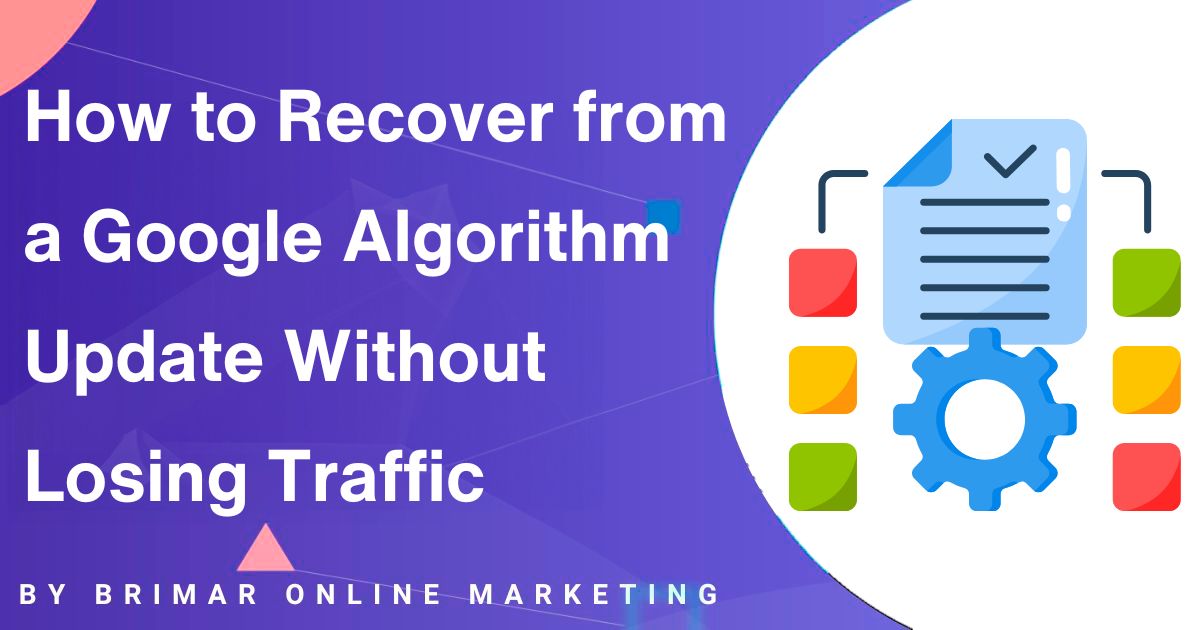
So, your website just took a nosedive in the rankings.
One day you’re comfortably on top, and the next, you’re scrambling to figure out what happened.
It’s frustrating.
Confusing.
Maybe even a little scary, especially when that organic traffic isn’t just numbers on a dashboard, but real leads, sales, and your business’s visibility.
When Google rolls out one of its broad core updates, it doesn’t tap anyone on the shoulder first.
Entire sites can see dramatic shifts in visibility overnight.
Pages that used to pull in steady traffic suddenly disappear from the top of the page.
Others get promoted for reasons that don’t seem clear at first glance.
But here’s the thing: it’s not about guessing.
There’s a way through it.
A real plan.
One that starts by understanding what changed, spotting where your site might have fallen short, and making the kind of improvements Google cares about.
That’s what this guide is here for.
You’ll learn how to spot what went wrong, fix what matters, and rebuild your site’s momentum with a focus on content quality, technical clarity, and practical SEO strategies that work.
First Thing to Understand. What Are Google’s Core Algorithm Updates?
Let’s clear up the confusion.
A broad core algorithm update isn’t a punishment.
It’s not some secret manual action taken against your site.
It’s more like a tune-up.
Google adjusts how it evaluates and ranks pages to deliver better search results for users.
Think of it as Google taking a closer look at how well your content lines up with what people are searching for.
These updates help the algorithm better understand relevance, trustworthiness, and whether your content effectively answers a search query.
So, if you’ve seen a ranking drop after one of these updates, it doesn’t necessarily mean your site did something wrong.
It may no longer be the best fit, for now.
That’s a key distinction.
Even John Mueller, one of Google’s most trusted voices, has said: “There’s no quick fix.”
These updates are broad, affect many sites, and often reward content that provides the most value to users.
This indicates that your role is not to manipulate the system.
It’s to improve what you’ve already built.
Start Attracting Customers Through SEO Today!
We can help you attract new customers through Tailored Search Engine Optimization Strategies for Your Business.
First Step: Confirm the Drop and Understand the Damage
Before you start fixing things, you need to know what happened.
- Don’t just assume it was the update.
- Go to Google Search Console and Google Analytics.
- Look at your website traffic.
- Are the numbers significantly lower than usual?
- Which pages lost traction?
- Which keywords dropped?
- Examine your sources of traffic carefully.
If you’re seeing a sharp decline in organic traffic specifically, that’s a strong indication the update has affected your site.
Next, try to isolate the issue.
Is this a technical issue, such as broken links, slow load times, or crawling problems?
Or are you experiencing a drop because your content no longer aligns with what Google considers valuable?
This is where an SEO tool proves useful.
Tools like Ahrefs, SEMrush, or Screaming Frog can help you run a health check.
They’ll highlight issues such as duplicate content, thin pages, or broken internal links that could be impacting your performance.
The goal here isn’t to panic.
It’s to get a clear picture.
Once you know where the damage is, you can stop guessing and start making changes that count.
Take a Closer Look at Content Quality

When your rankings decline, one of the smartest actions you can take is to analyze your content.
Do not just skim it; study it.
Ask yourself: Does this help someone searching for answers?
Or is it just fluff wrapped in keywords?
Search engines are no longer impressed by keyword stuffing or vague paragraphs padded to hit a word count.
Google’s algorithm is laser-focused on relevance, clarity, and value.
If your pages don’t deliver a clear answer to a real search query, there’s a good chance they’ll slide down the results.
- Start with a content audit.
- Look at every page as if it weren’t yours.
- Is the information up to date?
- Does it reflect expertise?
- Does it speak in a natural, helpful tone?
- Low-quality content stands out quickly once you stop making excuses for it.
- Common red flags?
- Thin content with no substance.
- Unnaturally repeating keywords.
- Articles that feel like they were written for search engines, not humans.
- Pages filled with jargon or copied content.
- Or worse, a generic filler that never answers the actual question behind the search.
Google’s documentation, such as the Search Quality Rater Guidelines, highlights the type of content that prevails: precise, accurate, and written by someone knowledgeable about the subject matter.
If you’re ever unsure, Google’s Help Center has a “Send Feedback” option for a reason.
They want site owners to reflect on what helps users, not what games the system.
If your site’s full of old posts that don’t perform, don’t just delete everything.
Improve them.
Update the facts, remove repetitive text, and restructure for clarity.
And while you’re at it, start publishing new blog posts that serve a purpose.
Content that answers questions, solves problems, or provides practical advice has lasting impact.
Good content doesn’t just help you recover from a drop; it builds real trust with visitors.
And that trust?
That’s what fuels long-term growth.
Technical Fixes. Don’t Ignore the Backend
Content may be king, but even royalty needs a solid foundation.
Technical issues can quietly undermine your chances of ranking well, regardless of the quality of your articles.
Let’s talk about the basics.
Page speed matters.
If your website loads slowly, users and Google won’t wait.
Run your site through tools like PageSpeed Insights or Lighthouse and see what’s slowing it down.
Large images, unnecessary scripts, and outdated plugins can pile up quickly.
Next, check for broken external links.
You’d be surprised how quickly they add up, especially if your site’s been live for a while.
Dead links don’t just frustrate readers; they signal to Google that your site might not be actively maintained.
Mobile usability is another one.
You’re losing traffic if your site isn’t easy to use on a phone.
Simple as that.
Google’s search algorithms prioritize mobile-friendly pages, so make sure your layout adjusts, buttons are clickable, and text isn’t crammed in tight.
Then there’s structured data.
Think of it like a cheat sheet for Google.
Incorporating schema markup enables search engines to comprehend your content more effectively, potentially enhancing your visibility in search results.
It’s beneficial for things like products, events, FAQs, or reviews.
Internal linking is another area where a few strategic changes can make a significant difference.
Linking related pages together helps users navigate and shows Google how your content is connected.
Ensure the links feel organic and truly beneficial.
Finally, check for canonical tags.
These indicate to search engines which version of a page is the original, helping to prevent duplicate content problems.
This is a minor yet important detail that is frequently missed.
Technical SEO may not be the most glamorous aspect of your recovery plan, but it’s a critical one.
Fix what’s broken.
Simplify where you can.
And give your visitors and Google a smooth experience from the moment the page loads.
Improve Your Backlink Profile

If you’ve noticed a sudden traffic drop after a Google core update, your backlink profile might be part of the problem.
It’s one of those areas many people overlook until rankings start slipping.
Start by reviewing your backlinks.
See who’s linking to you.
Use an SEO tool to pull a report and take a close look.
Are you getting links from low-quality directories or shady websites?
That’s a red flag.
Google’s algorithm keeps getting better at spotting junk links, and if you’re associated with too many of them, it can hurt your site’s credibility.
Focus on obtaining links from reputable, trustworthy websites within your industry.
Think of quality over quantity.
One link from a respected source is worth more than a hundred from random blogs no one trusts.
Steer clear of shortcuts such as paid link schemes or backlink farms.
They might seem tempting, especially if you’re trying to bounce back quickly, but they can backfire badly.
Reach out to websites that matter.
Create content that’s worth sharing.
Offer insight, value, and answers people are searching for.
The goal is to build a backlink profile that appears impressive on paper and supports your authority in search results.
Google’s updates are designed to reward helpful, trustworthy, and real sites.
Ensure your backlink strategy aligns with this.
Update Your SEO Strategy
Many businesses become stuck chasing rankings with outdated tactics.
That might’ve worked a few years ago, but the game has changed.
Google’s updates are smarter now, focusing on understanding real intent and surfacing content that genuinely helps users.
This means you need to move away from tricks and loopholes.
Forget keyword stuffing, clickbait, or obsessing over every little metadata tweak.
That stuff doesn’t cut it anymore.
What matters most is ensuring your content is explicit, useful, and genuinely answers the searcher’s question.
Take a look at your site and ask: Is it easy to navigate?
Do the pages load fast?
Are we speaking the same language as our audience is using to search?
That’s where your SEO strategy should be headed.
Use insights from tools like Google Analytics and Search Console to see what’s working and what’s not.
Adjust accordingly.
Focus on topics your audience cares about.
Think long-term, not quick hacks.
And if you’re ever unsure, lean on what SEO experts recommend; people who live and breathe this stuff and have their eyes on every shift in the algorithm.
The best SEO strategy today is simple: be useful, be clear, be honest.
That’s what Google is looking for, and it’s what your visitors appreciate most.
Boost Visibility Through Social Media and Other Channels

If your Google rankings just took a hit, the worst thing you can do is disappear.
You’ve got to stay visible.
That’s where social media comes in.
It’s fast, direct, and still one of the most powerful ways to reach your audience, even when your site isn’t at the top of the page.
- Share your most helpful content.
- Offer quick tips.
- Start conversations.
- And don’t just push links; connect with people.
If your brand feels human, people will stick around, no matter what Google’s algorithm decides that week.
Newsletters are another underused gem.
If you’ve built an email list, now’s the time to use it.
- Give your subscribers something worth opening.
- A short insight.
- A useful resource.
- A story that reminds them why they trusted you in the first place.
- And yes, YouTube still works.
- A simple video explaining a recent blog post or a walk-through showing your product in action can help drive engagement.
You don’t need fancy gear; you need clarity, honesty, and something worth saying.
The goal here isn’t to replace organic traffic.
It’s to keep the conversation going.
To show up, even when search engines don’t give you prime real estate.
If you do that consistently, you won’t just recover.
You’ll come back stronger.
Stay Updated and Be Proactive
Google doesn’t exactly send a personal memo when it rolls out changes.
But the signs are always there; if you’re paying attention.
Make it a habit to check trusted SEO blogs and industry news.
Not every update is a core update, but even the small ones can have ripple effects.
Understanding what lies ahead keeps you a step ahead.
John Mueller from Google often drops gold nuggets on X and in YouTube office hours.
They’re not always crystal clear (he’s still with Google, after all), but if you read between the lines, there’s real insight there.
When you notice significant changes in your traffic or search rankings, don’t panic – dig in.
Examine how other sites in your niche are responding.
Are they seeing similar drops?
Did they bounce back faster?
That kind of comparison can reveal a great deal about whether you’re dealing with something isolated or part of a broader trend.
The crucial aspect is to remain open to learning.
Don’t guess.
Don’t assume.
And don’t wait until your site disappears from Google to care about what’s happening.
You don’t need to obsess.
You just need to stay curious.
And when you combine that with smart action, you’re in a much better position to handle whatever update comes next.
The Good News. You Can Recover
Here’s the truth: even if your traffic took a hit, your site isn’t doomed.
A ranking drop after a Google core algorithm update feels brutal, but it’s not permanent.
And that’s the good news.
Sites that take the time to understand what went wrong and take action often emerge stronger than before.
Not overnight.
Not with some hack or trick.
But with consistent effort and the proper focus.
So, where do you put that focus?
Start with your content.
Not just more content, but high-quality content that answers real questions and reflects what users are searching for.
- Look at your most important pages.
- Do they still deserve to rank?
- Are they helping someone?
- Or are they just taking up space?
There’s a path forward if you’re committed to creating something valuable, updating what’s outdated, and fixing what’s broken.
Keep in mind that Google’s algorithm is constantly evolving to reward sites that genuinely serve the searcher.
If that’s your focus, you’re heading in the right direction.
Don’t rush the process.
The goal isn’t to patch things up quickly just to stay afloat.
It’s to rebuild something more substantial to withstand future Google updates without flinching.
Final Thoughts
A Google core update can feel like a slap in the face.
One week, you’re seeing steady website traffic, and the next, you’re wondering what just happened.
But instead of seeing it as bad news, think of it as a push, a reminder to sharpen your approach and bring real value to the table.
Yes, the algorithm changes.
Yes, it can be frustrating.
But it’s also a clear signal.
Google isn’t punishing you; it’s rewarding better experiences.
This truly allows you to distinguish yourself.
If a traffic drop has hit you, this is your moment.
Take a step back, run a real content audit, and look closely at your SEO strategy.
You don’t have to do it alone, either.
If you’d like a second set of eyes on your site, we’re offering a free site audit to help you identify what’s working, what’s holding you back, and where the quick wins might be hiding.
No pitch. No pressure. Just real insight to help you recover and grow.
Let’s fix what needs fixing, together.
Our SEO Services Have Helped Our Clients Increase Their Revenue!
“I highly recommend Brimar if your looking to grow your online business. You will be satisfied with the high level of expertise and high quality of services. It has helped my business grow by leaps and bounds.”
CEO

